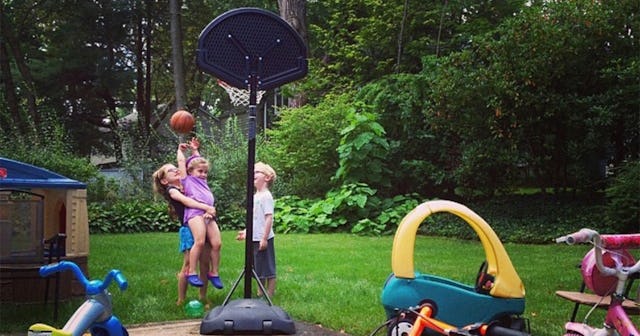10 Easy (But Effective) Ideas For Sensory Play––From An Occupational Therapist

Concerned that your child is developing sensory issues? Unsure of what you can do to help?
A lot, trust me.
There are so many simple and unacknowledged ways that we, as parents, caregivers, therapists, teachers, and educators, provide sensory information to our children on a consistent basis throughout the day.
Sometimes, when our kids are hyper-reactive to certain stimuli, boy are we aware of it! (Ever tried bathing a child with tactile hypersensitivity where you accidentally used the wrong cup and a splash of water went into their eyes, instead of the usual drip? My neighbors probably heard me on the next block!)
Here are a few simple and powerful ways that you have and can continue to help your child with sensory integration on a daily basis — because we need simple now, am I right?
1. Create your own ‘playground.’
Courtesy of Lauren Brukner
Pulling, pushing, sliding, and spinning are fun and active ways to integrate propriceptive (joint traction and distraction) and vestibular (balance and motion sense), where your child has control. Unable to get to a park? Create your own climbing activity set or obstacle course with indoor furniture/equipment, such as couch pillows, couch cushions, jump ropes, hoola hoops, balls, a chin-up bar, chairs, etc. Your child will have a great time creating their own “park!”
2. Allow them to get their hands and feet in the dirt or sand.
Courtesy of Lauren Brukner
Now that the weather is warm, consider having your child take on an active role in naturally messy outdoor play, such as gardening, or building sand castles and mud pies. It is important that at the same time, you provide them with control over this experience (i.e., allow them to wear gloves at first, use timers that your child starts and gradually increase the length of time, etc.)
3. Let them do their own hair.
Courtesy of Lauren Brukner
This is great for kids who don’t like hair brushing. The first time I tried this with my son when he was small, the change in this previously difficult ritual was instantaneous. He was so proud. Giving him control of tactile stimulation made this less scary for him. Plus, he looked cute!
4. Let them play with spare boxes.
Courtesy of Lauren Brukner
Do you ever have spare boxes laying around? Do your kids ever play inside them? Amazing! Not only are they utilizing imaginary play and social skills (if in a group), but are getting deep pressure from the boxes themselves.
5. Harness the benefits of bath time.
Did you know that playing in water is a tactile-based activity in and of itself? Three things that have worked for my sensory-sensitive kids when they were younger: a flexible cup that flattens near the forehead to minimize water in the eyes, lots of toys, and allowing my kids to take as much of an active role in the shampooing and rinsing as possible.
6. Let them give you a hand in the kitchen.
Courtesy of Lauren Brukner
Have your child participate in as much of the “dirty work” of baking as possible. I have found that my kids have been especially motivated to bake foods that they love, such as chocolate chip cookies. You can start with gloves, and when your child is ready, they can choose when, and if, they want to take them off.
7. Get them on a roll.
Bikes, scooters, tricycles — all those riding gear have your child integrate vestibular input. Are your kids able to ride their scooter or bike as a morning activity (maybe as part of a family run)? This may be a good way to start the day.
8. Utilize creative seating.
Pet beds can make for great (and reasonably-priced) seats, especially for those kids who like to feel cuddled (like my youngest, here).
9. Be generous with the hugs.
Credit: Abbie Sophia Photography
As a family, hug often (with warning to those who need it). Show and share the love.
10. Let them do some “heavy lifting.”
Courtesy of Lauren Brukner
Have your child carry something heavy as part of their daily routine (if medically cleared). At home, examples are pushing in and pulling out chairs, pushing a heavy laundry basket, etc. My oldest daughter has a daily ritual of lovingly schlepping our three-year-old ragdoll cat, Humphrey, across the house.
Finally, don’t forget to play along (when you can!) You may be surprised how great you feel!
Courtesy of Lauren Brukner
This article was originally published on